23rd JAMCO Online International Symposium
February 2015 - October2015
Audience Perception of Japanese TV Programs in Asia and the Middle East.
The use of television programs to promote lessons and knowledge about disaster prevention overseas
-Results of test viewing of NHK World TV programs to Thai students-
1. Introduction
One objective of JAMCO Online International Symposium is to show how Japanese television programs are perceived by viewers having different cultural backgrounds.
There are strong calls to strengthen the transmission of information from Japan and television program has been identified as principal mean. There are high hopes for international TV broadcasting. However, there has not been sufficient research concerning the viewers of such programs. The number of overseas households capable of viewing Japanese international broadcasting has grown, but we have not been able to ascertain who these viewers are. NHK has asked certain overseas viewers to act as program monitors, reporting their ideas and impressions to international broadcasting programs, but such monitors tend to be enthusiastic Japanophiles with a high level of interest in Japan – it is difficult to elicit critical responses from them. In order to expand viewers of Japanese international programs, we need to listen not only to people who have a particular affinity for Japan, but also to ordinary viewers.
As an experiment, we had students of national university (one of the country’s best educational institutions in Thailand) take part in a survey where they watched television programs broadcast by NHK’s international broadcasting service. These elite students who are poised to take up leading roles in Thai society are consider as potential audience for NHK’s international broadcasting.
The students watched 6 programs concerning the Great East Japan Earthquake of March 11, 2011. Each program had a different focus and a different production style. The programs included themes such as “The Lessons of 3/11”, “Thoughts and Feelings of Disaster Victims” and “Background to the Nuclear Accident”. All of these programs were originally created by a Japanese producer for Japanese viewers and so they had to be translated into English for broadcasting overseas. The Great East Japan Earthquake of 2011 caused an enormous amount of damage and a large number of TV programs showed people drawing lessons from this experience. These invaluable lessons and knowledge about disaster prevention are relevant not only in Japan, but indeed all over the world. Since the earthquake of 2011, the question of how to share Japan’s disaster experience and knowhow with the world has been a subject of discussion in various international conferences. It has often been remarked that television programs concerning the disaster can serve as soft power of Japan in international community.
For this report, our subjects were Thai university students. Needless to say, they have a different cultural background and a different awareness of disasters from people in Japan. We had them watch programs related to the Great East Japan Earthquake and then conducted group interviews to hear their ideas and impressions and figured out what kind of programs they like.
2. Background and overview of the survey
(1) Japan’s international broadcasting
NHK World is NHK’s international broadcasting service. It transmits news and information from Japan to the rest of the world and it has the following aims (http://www3.nhk.or.jp/nhkworld/japanese/info/aboutus.html):
- To provide both domestic and international news to the world accurately and promptly.
- To present information from Asia from various perspectives, making the best use of NHK’s global network.
- To serve as a vital information lifeline in the event of a major crisis, accident or natural disaster.
- To present broadcasts with great accuracy and speed on various aspects of Japanese culture and lifestyle, recent developments in society and politics, the latest scientific and industrial trends and Japan’s standpoint and opinion regarding important global issues.
- To foster mutual understanding between Japan and other countries and to promote friendship and cultural exchange.
NHK World has three main services for carrying out these aims. NHK World Radio, which began operation in 1935, currently broadcasts news and other programs in 18 languages. NHK World Premium which targets mainly Japanese people living overseas transmits Japanese-language programming including news, entertainment and sports. The third service is NHK World TV which launched in 2009. It is aimed at foreign audience and broadcasts in English 24 hours a day, featuring the latest news from Japan, Asia and the rest of the world as well as a wide range of other programs. It can currently be viewed in 140 countries and regions.
The survey in this study is focused on NHK World TV and therefore examines how programs on the Great East Japan Earthquake in English were perceived by Thai students. NHK World TV reports the news every day on the hour and it broadcasts a variety of programs at the rest of time. These include programs produced specially for international broadcast and also NHK programs produced for Japanese viewers which have been put into English. After the Great East Japan Earthquake, a lot of programs related to disaster were translated into English and were broadcast overseas. This is a way to convey to the world the experience of disaster as well as lessons which might be used for disaster prevention and mitigation outside Japan. Apart from being edited for length, the programs were broadcast as they were domestically with the addition of English narration and interpretation.
(2) Overview of the Survey
This is an overview of the survey.
- Date: October 9, 2014
- Implementation location: Classroom at campus of a national university in Bangkok, Thailand
- Participants: 13 students of the university (3 men, 10 women)
- These Thai students were recruited by professors at the university. We needed students who could understand English to some extent and are considered as “ordinary” viewers. Therefore, we stipulated that participants should be students taking English courses, but not studying media or doing research on Japan.
- Survey procedure
- *The participants filled in a questionnaire to inform their basic information (20 minutes).
- *They watched the opening sections of 6 NHK programs concerning the Great East Japan Earthquake, filled their impressions in questionnaire and then gave ranking of 6 programs (60 minutes).
- *Group interview (one group of 7, one group of 6; 70 minutes each)
- Language: English
- Targeted programs were all documentaries concerning the Great East Japan Earthquake produced by NHK. The 6 programs in question differed in topic and production style are listed below:
- Mega Tsunami: How can lives be saved? (aired on May, 2011)
- Can You See Our Lights?-First Festival after the Tsunami (aired on August, 2011)
- Japan’s Nuclear Crisis: What Caused This Massive Disaster? (aired on June, 2011)
- The Triple Quake Scenario: Bracing For the Next Tsunami (aired on September, 2011)
- Disaster Big Data: Saving Lives Through Information (aired on March, 2013)
- Rebuilding the Manufacturing Kingdom, Tohoku (aired on June, 2011)
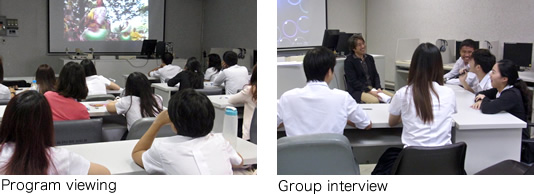
With regard to the topics of the programs, we though that Thai participants would connect strongly with 1 and 6, weakly with 3 and 5 and not at all with 2 and 4. With regard to production style, we tried to draw comparison between Program 1 (Mega Tsunami: How can lives be saved?) which featured studio presenter and Program 2 (Can you see Our Lights?-First Festival after the Tsunami), a human document that focused on the feelings of disaster victims. Program 1 was a very prominent earthquake-related program from the point that when it was broadcast in Japan, its viewer rating was nearly 20 percents. Furthermore, it received high praise when it was provided free of charge to foreign TV channels through the Asia-Pacific Broadcasting Union (ABU). Program 2, with its sensitive depiction of the thoughts and feelings of disaster victims won the Intermedia Globe Gold Award (first prize) in the Documentary: Human Relations and Values category of the World Media Festival. However, in Japan, programs focusing on disaster victims have been found to receive relatively poor ratings and the program theme “restart the festival” seemed rather to be remote from the concerns of Thai viewers. Therefore, we will principally compare the production style of these two programs in this survey.
3. Results of the Questionnaire and the Program Viewing Survey
(1) Basic data of the Participants
First, I describe the basic information of the survey participants (See Table 1). They were all university students ranging from first-year to fourth-year. We had expected to recruit an equal number of men and women, but finally, women were superior in number. Most of them were majoring in fields such as economics and business. Almost all of them had visited a number of countries and seemed to have a relatively high level of interest in overseas news. CNN and BBC had a high degree of recognition, whereas only 5 of the 13 students knew about NHK World TV and only 2 of them had actually watched it (both on cable).
As for television viewing habits, 8 participants were watching TV for less than one hour a day, 2 people were watching for one to two hours a day and 3 people were watching for more than two hours a day. Apart from news, they were interested in dramas and variety programs. Some of them were fan of Korean dramas, other popular programs included singing program with a format that originated in the Netherlands and cooking shows.
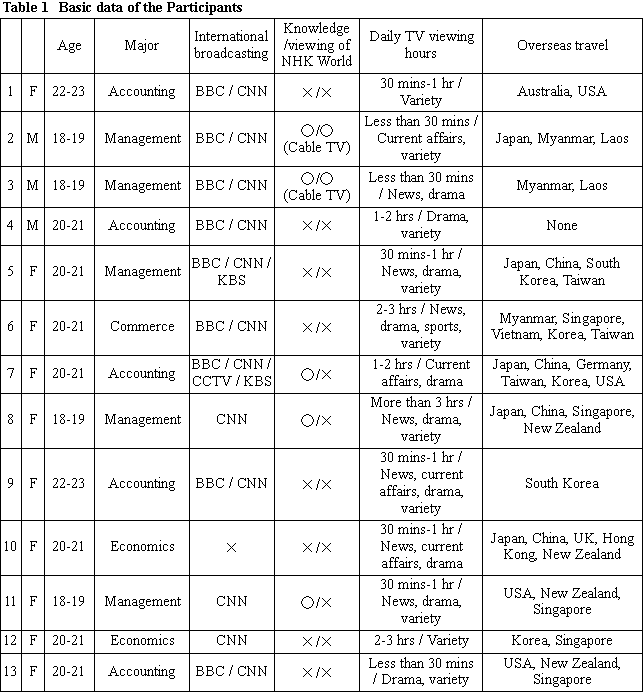
(2) English Proficiency of the Participants
When we asked the students what English tests they had taken and their scores, they mostly said that they had taken a test called CUTEP which was developed by Chulalongkorn University in Thailand. We looked at their CUTEP scores and determined that they were around 80 points level on TOEFL ibt or 700 points level on TOEIC. There were no students majoring in English in the group, but students need a fairly high level of English to enter a top university in Thailand. The 12 of the 13 students were watching international news on networks such as CNN and BBC, the majority answered that they did this as a way to study English, rather than as a way to acquire information about current events.
(3) Disaster Awareness of the Participants
We used the questionnaire to ascertain the participants’ awareness of natural disasters. First, we asked them whether they know about the Great East Japan Earthquake and the result was that 12 of the 13 students answered “yes” and 1 student “no”. We then asked if they had seen footage of the damage caused by tsunami which accompanied the earthquake. The 11 of the 13 students responded that they did. Among the 11 students who said they had seen footage, 8 students had seen it on the news programs of Thai networks, while 3 students had seen on YouTube. When we asked them how closely connected they feel to the damage caused by the March 2011 tsunami on a five-point scale (Table 2), there were no students who feel very close. 1 student feel a strong connection, 6 students feel average connection and 5 students said they feel weak connection. 1 participant feel no connection at all, because the damage caused by the Great East Japan Earthquake happened a long way from Thailand.

(4) Results of the viewing survey
The Procedure of Program Viewing
After asking the participants about their basic information, program viewing was carried out as follows:
1) Before watching program, we asked their impression to the title and their interest level to the topic on five point scale.
2) We had the participants watch the opening section of program (roughly 4-5 minutes), because the essence of the program is shown in a condensed manner.
3) After they watched the opening, we asked the participants to what extent they understood and their level of interest in watching the rest of the program (both on a five-point scale). If there were any parts of a program they did not understand, we asked them to write the reasons why they did not.
4) We asked them to describe what kind of content would make them to watch until the end.
5) After they watched 6 programs, we asked them to rank the programs in order of preference.
6) We divided the participants into two groups and conducted interviews. The first group was consisted of 7 students who had ranked Program 1 (Mega Tsunami: How can lives be saved?) or Program 2 (Can You See Our Lights?-First Festival after the Tsunami) as their top choice. We had them watch the main part of each program for 10 minutes and asked their thoughts and feelings to the programs overall including the production style. The second group was consisted of the 6 other students. We asked them the reason they had ranked the programs in that way and what would make the programs more attractive to Thai audience, their ideas about how the programs should be improved.
Results of the Questionnaire
We will now describe program by program, the content and the results of the survey conducted after viewing,
Program 1 – Mega Tsunami: How can lives be saved?
The Great East Japan Earthquake caused enormous damage. What occurred on the seabed off the Sanriku Coast? The program tries to give the full picture of the gigantic tsunami, using footage captured in real time by NHK and local people, accounts from disaster victims and analysis by experts. It shows how the huge tsunami generated and how it struck coastal towns and villages. It also shows what people thought and did between the earthquake and the arrival of the tsunami. Using videotape recorder, studio presenter talks about what is necessary to save lives.
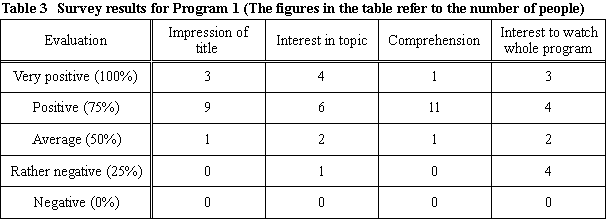
First, the program’s English title Mega Tsunami: How can lives be saved? elicited a positive reaction from almost all the students. However, interest in the topic was rather low. This may be because the Great East Japan Earthquake is a disaster that occurred far away to the Thai students – the results regarding how intimately connected the students felt to the disaster also born this out. After watching the program, 11 people responded that they understood around 75% of the program, 1 student understood almost 100%. As reasons for failing to understand, the following were cited: pronunciation of English, lack of knowledge about the background of disaster and cultural differences between Thailand and Japan when it comes to disaster prevention. Regarding their desire to watch the program all the way through, 7 students gave positive responses while 4 students responded negatively.
When we asked what kind of content would make them to watch, there are comments such as “I would like to know more in details about how to save lives”, “There are too much information overall, so I want them to reduce information”.
Program 2 – Can You See Our Lights?-First Festival after the Tsunami
Many towns suffered as a result of the Great East Japan Earthquake, making it very difficult to hold summer festivals that had been going on for hundreds of years. Among these towns were many that took the bold step of going ahead and holding the festivals “as a way of praying for the repose of the souls of family and friends who had died in disaster.” One such place was Rikuzentakata City in Iwate Prefecture. There were people saying that the idea of holding a festival at the time was ridiculous, but they decided to go ahead because they thought it was the very thing needed . The program covers the days leading up to Tanabata (Star) Festival in Rikuzentakata City and shows the thoughts and feelings of the people as they prepared.
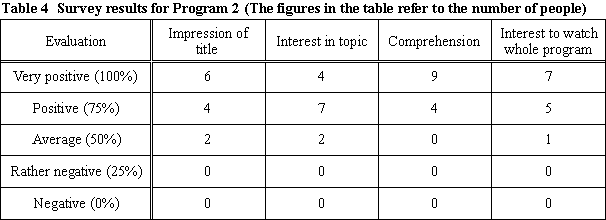
The program’s title made a positive impression overall. Furthermore, there was a reasonable level of interest in the topic, but not dramatically compared to other programs. The most distinctive feature is that all of the students said they understood at least 75% of what they saw. This number include 9 students who responded that they had understood roughly 100%. 12 students stated that they want to watch the whole program.
When we asked them what they look forward to the rest of the program, answers were the following:
- “I want to see all of the preparations leading up to the festival as well as the festival itself.”
- “I’d like to see the daily live of people as they try to recover from disaster.”
Program 3 – Japan’s Nuclear Crisis: What Caused This Massive Disaster?
This program is about the nuclear accident which followed the Great East Japan Earthquake.
Beyond the assumption, hydrogen explosions and meltdowns occurred and a reactive approach to the crisis magnified pollution damage. Why aggravation of the accident ? The Cabinet, the Nuclear and Industrial Safety Agency, the Nuclear Safety Commission and Tokyo Electric Power Company were all dealing with the accident – how did they respond? This is a thorough investigation based on testimony of parties and internal documents.
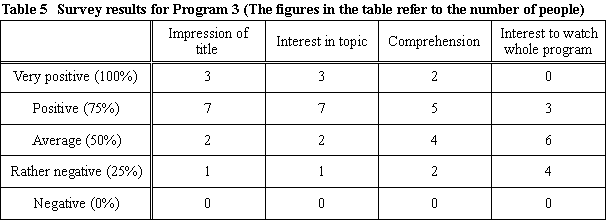
The title and topic drew generally positive responses. However, the students’ comprehension was low, 6 students saying that they understood less than half of the program. The main reasons for their poor understanding are the lack of knowledge about nuclear power and the difficult English vocabulary used in the program. We believe that the source of difficulty was the inclusion of technical terms. Therefore, just a few students answered that they want to watch the program until the end.
When we asked what kind of content would make them to watch until the end, answers were the following:
- “I’d like the program to propose some solutions to settle nuclear accidents.”
- “I’d like to know whether the accident could have been prevented.”
- “I think the background music should be changed. It sounds like music for a horror movie.”
Program 4 – The Triple Quake Scenario: Bracing For the Next Tsunami
The Great East Japan Earthquake reignited concern about the possibility of “triple quake”: the Tokai, Tonankai and Nankai plates moving simultaneously. The extent of possible damage and planned measures were carefully reviewed and new research revealed under what condition huge tsunami generate. Experts predict that tsunami of a nearly double size could strike the coast and possibly reach cities which have been assumed to be safe. What must be done to save lives? The program reports the latest research and efforts underway across Japan.
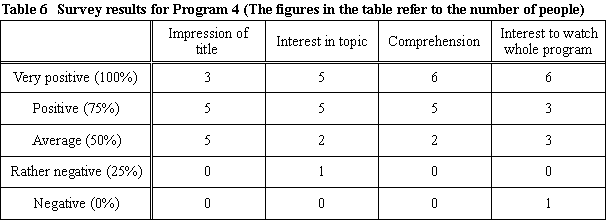
The impression to the program’s title was not especially positive, but there was a reasonable level of interest for the topic. Comprehension was relatively high, with 11 students saying they understood 75% or more. 6 students expressed a strong desire to watch the whole program.
As for what students wanted to see in the rest of the program, they expressed the following opinions:
- “I want to see in the program what kind of technology is useful to reduce the damage of tsunami and how it functions.”
- “The CG was fantastic, but I want to get a clear message about plans to prevent disaster.”
- “I want to know for what the local people fear and how they provide against it.”
Program 5 – Disaster Big Data: Saving Lives Through Information
The Great East Japan Earthquake left 18,500 people dead or missing. Attempts to analyze various forms of big data: the actions of hundreds of thousands of people in the devastated areas, the records of GPS-equipped vehicles and 180 million tweets sent in a week after the disaster. In the program, big data reveal complete picture of the Great East Japan Earthquake, including information that cannot be gleaned from recovered video alone: What were their priorities ? How did they react on the day of the disaster?
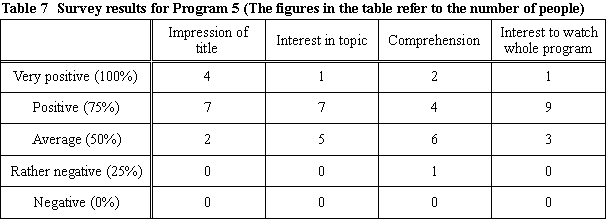
The impression to the title was not bad, but interest in the topic was slightly low. Comprehension was even lower. Some of the reasons given were:
- “The topic is new for me and I couldn’t adapt to it.”
- “The vocabulary is difficult and I couldn’t understand the explanations given in some parts of the animation.”
- “The English used in this program was too fast.”
As for what students want to see in the rest of the program, they expressed the following opinions:
- “I’d like to get some concrete examples of how big data is used.”
- “I’d like to know how big data is useful in case of disasters in future.”
Program 6 – Rebuilding the Manufacturing Kingdom, Tohoku
The disaster damaged small factories in Tohoku region, rendered them unable to manufacture components. This resulted in problems with the automobile manufacturing supply chain around the world, making it clear how important Tohoku’s manufacturing industry is to the global economy. Using the damaged manufacturing field as the entry point, the program employs multifaceted reporting to analyze automobile and semiconductor production at the same time seeking a path for Japan’s economy and Tohoku.
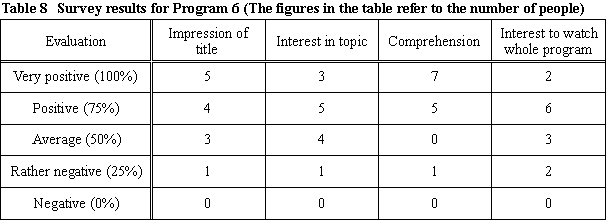
Concerning the program Rebuilding the Manufacturing Kingdom, Tohoku, opinions were split between negative opinion and positive opinion regarding the impression of title and interest in the topic. Overall, comprehension was high. This is because the participants studying business and economics have basic knowledge about the topic. Furthermore, the flood disaster which occurred in Thailand in 2011 caused supply chain in the same way as the manufacturing industry in Tohoku. Views were divided regarding the desire to watch the program through to the end.
As for what students want to see in the rest of the program, they expressed the following opinions:
- “I want to see how other industries are affected by disaster.”
- “I would like to know how the earthquake affects Japan’s economy.”
- “I would like to know how it influences other countries.”
- “I want to find out solution to resolve these problems.”
(4) Ranking
Table 9 shows the participants’ ranking of the programs. Program placed on top counts for 5 points, second 4 points, third 3 points, fourth 2 points, fifth 1 point and sixth 0 point. Total point was calculated and the ranking was:
- Program 2, Can You See Our Lights?-First Festival after the Tsunami (52 points)
- Program 6, Rebuilding the Manufacturing Kingdom, Tohoku (36 points)
- Program 5, Disaster Big Data; Saving Lives Through Information (32 points)
- Program 4, The Triple Quake Scenario: Bracing For the Next Tsunami (28 points)
- Program 1, Mega Tsunami: How can lives be saved? (24 points)
- Program 3, Japan’s Nuclear Crisis: What Caused This Massive Disaster? (23 points).
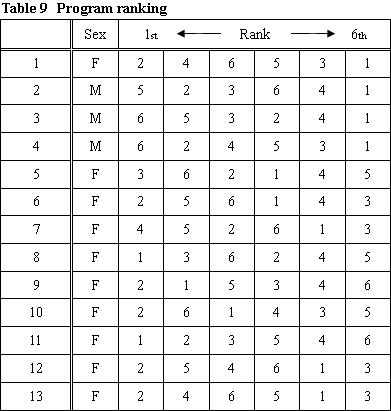
Thai students placed the Program 2 on top. It was ranked first by 6 of the 13 participants and ranked second by 3 participants. There was a positive reaction towards this program as a whole. Opinions were divided on Program 6 which received the second highest score; though it was ranked first by 2 men, it was ranked sixth by 2 women. Similarly, Program 5 which received the third highest score was ranked first by 1 man but was ranked last by 2 female students. Such results show that tastes vary from person to person. Program 4 which came in fourth was ranked high just by a few people, but no one put it in last place. Program 1 which was ranked fifth was placed first by 2 people, but was placed last by 4 people. Program 3 which came in sixth was also placed last by 4 people.
It goes without saying that low ranking does not mean a program was poorly made. The ranking was based on the subjective judgment and feelings of the Thai students. Looking at the results, it is necessary to bear the following points in mind:
- The group was composed mainly of female students.
- Most of the participants were economics and business majors.
- Correlation was seen between comprehension of programs and popularity.
4. Results of Group Interviews
(1) Group interview flow
Subsequent viewing interviews were conducted in two groups. The first group consisted of students who had chosen either Program 1 or 2 in first place. The second group consisted of the other students.
The following were the main questions asked:
1) What are your reasons for choosing this program as your favorite?
2) What are the good points and bad points of this program? Please tell me things you couldn’t understand in the program.
3) How was the program different from a regular Thai program?
4) How to improve the program so that Thai viewers would be more likely watch it?
We had the first group watch the main part of Program 1 and 2 for ten minutes. Afterwards, we asked them to compare the openings and the main sections. Furthermore, we asked them to tell us their thoughts and feelings about the production style and content of the program.
(2) Results of Group Interviews
Criteria for Program Ranking
We asked the students their reasons for ranking a particular program in first place.
Program 1 Mega Tsunami: How can lives be saved?
- “It is different from the programs you see in Thailand. It is very real. There are a lot of video of the actual events and interviews to actual survivors.” (Student 11)
- “This kind of documentary is rare in Thailand. It is really creative and I wish there are more programs like this produced in Thailand. It showed how to prepare for disaster.” (Student 8)
Program 2 Can You See Our Lights?-First Festival after the Tsunami
- “I got information about the Great East Japan Earthquake on TV, I heard about it from my professors and I also saw video on Internet. However, this type of documentary helped me understand much better the situation of people who are affected by disaster. It’s a tragedy that happened in real world. I felt that it is like a fiction movie, but it isn’t. It conveys the feelings of the people who appeared in it and I was moved with sympathy. I want to watch it through to the end and to see how they overcome their difficulties.” (Student 13)
- “After the disaster, there was disagreement about whether the festival should go ahead or be cancelled. I think that the same kind of disagreements would also happen in Thailand and so I found it easy to relate to.” (Student 1)
Program 3 Japan’s Nuclear Crisis: What Caused This Massive Disaster?
- “As there has been discussion about building nuclear power plants in Thailand, we need to know the effects of this kind of accident. In Thailand, we mainly adopt thermal power generation using coal and this causes pollution problems. I’ve heard that nuclear power generation is clean. We’re part of the new generation and so we need to take an interest in this topic. I’d like to see more NHK programs about nuclear power. It’s a thorny subject and it would be good to learn a lot from these programs.” (Student 5)
Note: Nuclear power generation has been a topic of debate in Thailand for quite some time. In 2012, however, in light of the Fukushima I Nuclear Power Plant disaster, Thailand’s Deputy Prime Minister declared Thailand’s intentions to abandon nuclear power generation. It has since been focusing on thermal power generation.
Program 4 The Triple Quake Scenario: Bracing for the Next Tsunami
- “I chose this program because it shows something that hasn’t happened yet – it shows a future scenario like“prediction”. It makes us realize that the same thing could occur. I want to find out how Japanese people would prepare for this scenario. This is something that would occur in Japan, so there might not be any direct connection with Thailand. However, if it happens, it would have worldwide significance.” (Student 7)
Program 5 Disaster Big Data: Saving Lives Through Information
- “Information is the most important thing today and ICT (information and communication technology) is bringing big changes to our life. To learn how to use ICT in form of big data will be very useful to prevent disasters in future. Thai people can make use of it, too. This is not an issue just for Japan, but it is a common issue we have to share. Knowledge of technology is a modern topic.” (Student 2)
Program 6 Rebuilding the Manufacturing Kingdom, Tohoku
- “This program gave me a good understanding about economic globalization. As I major in business, this program was the one I understood the best the content among the 6 programs. I would like to be involved in global business in future.” (Student 3)
- “The concept of supply chains interested me. I thought it could be useful for me in the future.” (Student 4)
(3) Comparing the Performance technique of Programs 1 and 2
We had the participants in the first group – the students who chose Program 1 or Program 2 as their favorite – watch the first ten minutes of each program. Then, we asked their thoughts and impressions. During this session, Program 2 was overwhelmingly well received while Program 1 was judged harshly.
Main Thoughts and Feelings about Program 1
Even though this is a program of one hour, we heard comments such as “I feel it too long.” or “There are too much information.”
- “I think it is an excellent idea to find survivors who had experienced the disaster and bring out lessons by interviewing them. The footage transmitted the lessons fully. However, there were too many explanations before we got to those lessons and it’s too long. I got bored.” (Student 13)
- “It has a lot of lessons and that’s why I ranked it in first place. However, I think that the program is too long for Thai people. There were too much information. I think that some parts could be summarized and if the length brought down to 30 minutes, Thai people might watch it.” (Student 11) [In connection with this idea, there was comment such as “It would be a good idea to split the program into 5-10 minutes, each focusing on one narrow topic.”]
There was also the fact that the information provided by the program was insufficient in some places and they couldn’t understand well the program. This may have something to do with the students feeling that the program was too long. In translating Japanese programs for international audiences, we provide additional information in form of subtitles. However, the survey suggests the need for more improvement in this area.
- “In the programs, names of different towns were mentioned. However, even if I hear Japanese place names, I can’t get any image of them. Using comprehensive map will make it easier to understand. It would be better if they use a big map that shows the position in relation to a well-known city like Tokyo; zooming from geographic place and changing to actual footage.” (Student 9)
There were also some negative opinions about the studio presenter.
- “I felt it was really awkward the way the presenter was alone in the studio, standing all the way and not moving while giving the report. In Thailand, a moderator or host in the studio is usually sitting and there’s more movement with the camera. I think it’s boring just to have a constant shot of the presenter’s face.” (Student 10)
Main Thoughts and Feelings about Program 2
We did not hear any negative comments about Program 2. The feedback we received included comments saying it evoked various emotions in viewers, such as sadness and hope and it was a program that made them think.
- “Even though it’s a documentary, it has a dramatic story. There was a man who was filled with sorrow after losing six members of his family. If I were in his situation, I don’t think I could get over it. The program was emotionally compelling. I think it speaks to Thai people’s hearts. I want to watch it through to the end. I would watch this program regardless of how long it was.” (Student 10)
- “It was a very sad program. But I still want to watch it till the end. I want to see how the festival could help the man who lost his children get over his pain.” (Student 12)
(4) Concerning the language used in programs
Program 1 was dubbed into English by interpreter while Program 2 was read by native English narrator with a great deal of sensitivity. This seemed to account for much of the difference in the students’ reactions to Program 1 and 2.
- “In Program 1, the voice of the male presenter was dubbed using the voice of a female interpreter, it seemed awkward to me.” (Student 10)
- “The interviews in Program 1 were dubbed using the voice of an interpreter while in Program 2, the voices of the disaster victims were left in Japanese and had subtitles in English. I couldn’t understand what they were saying in Japanese, but they communicated their feelings through their voices. They communicated their emotions well.” (Student 9)
- “In Program 2, the female narrator was good. Her voice informed us about the incident more than video. I was able to grasp what was happening from the feeling of the voice.” (Student 1)
When we asked both groups of students how to improve the programs, there were a lot of requests concerning the narration and the subtitle. The main ideas were as follows:
- “The interpreter’s voice was monotonous. It would be better to have a narrator who conveys not only information but also the nuance. It is important to intonate with feeling.”
- “It would be good to have English subtitles in the interviews so that the original Japanese can be heard.”
- “When there’s a shot of the presenter making comment like in Program 1, it would be good to keep the Japanese and using the English subtitles.” (As mentioned above, the presenter’s remarks being too long also drew negative comments.)
- “It would be good to include animation or computer graphics as visual supplement to help people understand the content even if they are unable to catch English.” (There was also comment saying it would be best to have subtitles in Thai language.)
(5) Comparing Japanese and Thai Programs
Survey result of the 6 programs viewing showed that regardless of whether the programs are considered good or bad, the impression of the students to Japanese documentaries was that they are different from Thai programs. In the final analysis, one positive aspect of the Japanese programs was that the footage of actual events was impactful and persuasive. Furthermore, students appreciated that the programs were full of important messages such as lessons regarding disaster prevention.
On the other hand, the most prevalent negative comment was that the programs were too serious. The students became bored with expository programs where commentary took precedence over images. When we discussed what kind of programs they would like to see, they mentioned a combination of Programs 1 and 2. In other words, in a dramatic human story such as Program 2, lessons on disaster prevention conveyed in Program 1 could be subtly added.
5. Conclusion
Will people watch programs on disaster prevention?
Thai people are not greatly interested in disaster prevention. Among the students who took part in this survey, there were some who knew nothing about the Great East Japan Earthquake and had not seen footage of the tsunami. During the group interviews, several of the students mentioned that Thai people are temperamentally disinclined to take an interest in disaster prevention.
- “Thai people forget things easily. When something happens, they get excited but they settle down soon. So even if they hear the problems that can be caused by tsunami, I don’t think they would really take it to heart.” (Student 3)
However, students participated in the survey seemed more interested in disaster prevention than ordinary person and were aware of its importance. If they had the opportunity to watch programs about disaster prevention, they would have a desire to do so. If we compile the results of this survey, the following points should be considered.
- The overall impression of the six programs concerning the disaster prevention was generally favorable, but when we examine the program on concrete level, impressions were scattered. Even though program was judged to be “good”, sentiments such as “I wouldn’t watch it if I don’t feel it would interest me.” or “I was interested when I started watching, but I lost interest soon after.” were expressed. These remarks indicate that if the programs do not live up to the image of title and topic, it is highly likely that people will change the channel.
- Even if the topic of the program doesn’t have direct connection with viewers, program could arouse viewer’s interest through its performance technique. At the same time, even if viewers were interested in topic, they would not watch the program all the way through when they feel uncomfortable with the performance style.
- The essential is to reduce difficulty to promote understanding. Thai viewers being non-native speakers of English, it is difficult for them to understand the explication using technical words related to disaster prevention. It is necessary to devise performance techniques, introducing animation or computer graphics to promote understanding of the viewers.
- The impression of several students with NHK programs was that they are serious. Students feel that they are unsatisfactory because of the insufficient impact even though the programs are useful for study purposes. It would be difficult to solicit students to watch program just for the reason that “even though the program is not fun, it is good for study”. Programs that evoke sympathy and empathy with people featured there are more readily acceptable than those that focus mainly on theory and argument.
- The participants said that the programs were conveying “reality”, but they also said that as the programs were relatively dull and long, they got bored with them. We believe that it’s necessary at least some extent to introduce local (Thai) production methods and add elements such as surprise and variety to the programs.
Anothai Udompslip is head of the Academic Institute of Public Media of Thailand’s public broadcaster, Thai PBS. We asked him about the fact that the students have a sense of discomfort with the production style of some of NHK’s documentaries. He said that documentaries take a lot of time and money to produce. He added that it requires a high level of ability to produce these programs and for all these reasons, Thai broadcasters produce very few documentary programs of the same standard as BBC or NHK. Analysis has shown that even if it is about programs treating social problems, Thai viewers have a preference for production style in which studio moderator and guests engage in lively discussion because they are accustomed to it.
To promote program viewing, programs must be in comprehensible level. In that respect, English is a big obstacle. Thailand is a country where English is studied in school but not used in daily life like Japan. While interest in learning English is high and the English proficiency of university students is improving, they are different from people in places like Singapore or the Philippines where familiarity with English comes from its use as second language. Suchada Nimmannit who cooperated with us on this survey and teaching at the Thai national university explained that English ability of the students had affected their comprehension to the programs. She said that Can You See Our Lights?-First Festival after the Tsunami seemed to be a program that appeals the most strongly to Thai people’s feeling and with regard to the ranking of other programs, her analysis was that there is a connection between the participants’ level of comprehension and preference to the programs. If NHK broadcasts international programs dealing with topics specific to Japan, consideration should be given to the use of English such as the choice of words and speed of talking. In particular, Asian people neither hear nor use English words related to disasters and specialist terms concerning disaster prevention on a daily basis and so even when making comments in the program, the fact that most of the viewers are non-native speakers of English should be taken into account.
Hopes for NHK World TV Programming
Finally, we would like to report what kind of programs the Thai students said they wanted to see on NHK World. Table 10 shows the results of a survey in which the students gave a number of responses about the kinds of programs they would like to see on NHK World.
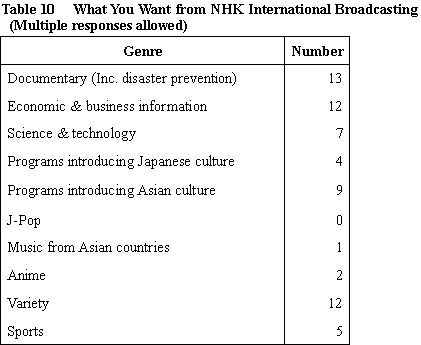
We asked the Thai students about their impression of NHK World and what kind of programs they would watch if NHK broadcast them. They responded whatever came into their minds and their main ideas were as follows:
- “I’ve seen NHK World before, but I got the impression that it’s too Japanese.” (Student 2)
- “I’d like to see more programs on Asian culture. In regards to news, I’d like to see economic and financial news. I’d also like it to be easier to watch. It would be great if NHK would post videos on YouTube in addition to the live streaming on the website.” (Student 6)
- “I’d like to see variety shows. I’d also like to see interesting programs from various countries.” (Student 11)
- “I’d like to see variety shows, programs like singing contests and cooking contests that feature food from various Asian countries.” (Student 12)
- “I like to watch variety shows, but there are already a lot of them on Thai TV and so I’d like to see more good documentaries. I’d also like to see programs on disaster prevention.” (Student 13)
- “Documentaries and soap operas. I think soap operas are a powerful tool for transmitting information. They draw a lot of people in and convey country’s culture. Korean dramas are popular in Thailand. They help us learn about Korean culture, things like food and fashion. Japanese dramas are also well known in Thailand. I’d also like NHK World to broadcast Thai dramas because I’d like people to become familiar with Thai culture.” (Student 9)
- “I’d like to see documentaries on Asia. I don’t think there are many high-quality documentaries about Asia. I think it would be wonderful if NHK could represent Asia by producing good programs that express how Asia is thinking.” (Student 12)
The students mentioned that the programs broadcasted internationally by NHK are too serious, whereas the survey also indicated that actually, they have desire to watch this kind of serious program. Regarding programs about disaster prevention, they explained that ordinary people in Thailand would not want to watch programs about disaster prevention, but they themselves would. We feel that there is potential demand here.
This report presents the results of an experimental group-interview-style survey. It was conducted from the standpoint of viewers to get a sense of what they think about programs of NHK International Broadcasting. It’s often said that in international broadcasting, it is difficult to recognize the viewers. Not hear polite platitudes but see how people overseas really feel after watching Japanese international broadcasting program and what impression they get from them, there is no substitute for seeing their faces and their reactions and listening to what they say. Students of a national university in Thailand participated in group interviews as potential viewers of NHK World TV. As survey participants were just a part of the whole viewers, gender balance was one-sided and the survey was experimental, the more ingenuity with regard to the choice of programs and the viewing methods would have made the survey better. The viewers of NHK World are diverse so that it is probably impossible to fully grasp how the viewers think by a single survey. However, looking for the way to highly enhance the satisfaction of the main viewers, therefore, narrowing down the target viewers of survey will consequently enable to increase viewers. The utilization of “lessons and knowledge about disaster prevention” in other countries, furthermore, transmission of Japanese television programs will deepen mutual understanding, friendship and cultural exchange between Japan and other countries. We hope that NHK World will continue efforts to facilitate such contributions for international community.
Takanobu Tanaka
Senior Researcher
Senior Researcher, NHK Broadcasting Culture Research Institute
Senior Researcher, Media Research & Studies Division, Broadcasting Culture Research Institute, Japan Broadcasting Corporation (NHK)
B.A., Sophia University, Department of Foreign Language
M.A., University of Leeds, Studies of International Society and Culture
Ph.D., Nagoya University, International Development
Working at NHK as a broadcast journalist since 1988, moved to NHK Broadcasting Culture Research Institute in 2011. Main research themes include disaster broadcasts, international cooperation and global trends on public media.
 Return to 23rd JAMCO Online International Symposium contents page
Return to 23rd JAMCO Online International Symposium contents page








